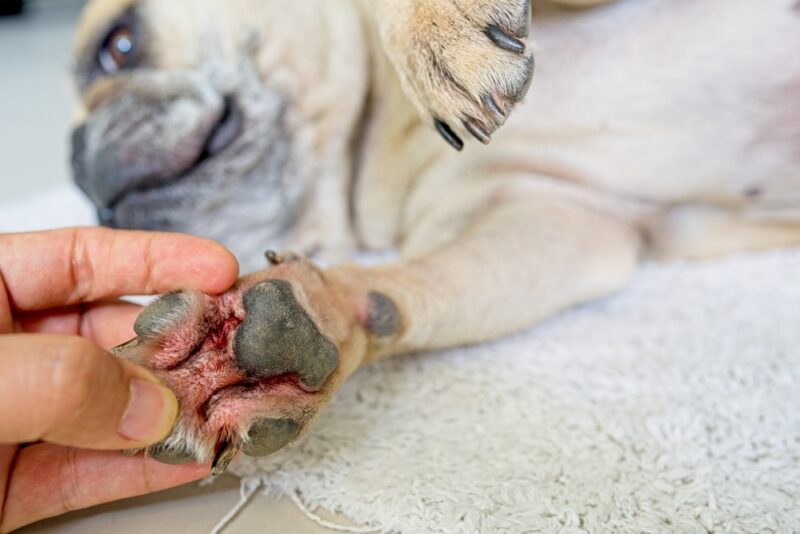Lick Granuloma in Dogs: Causes, Signs, and Treatments (Vet Answer)

Updated on
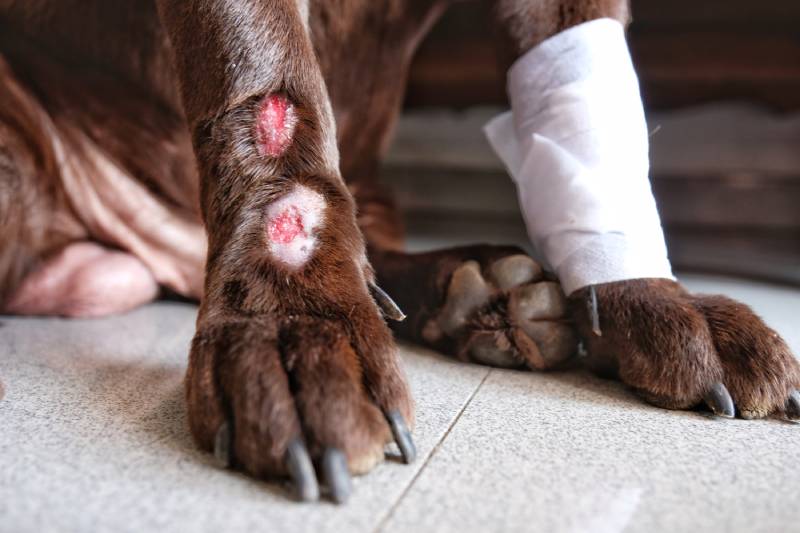
Lick granuloma in dogs is a relatively common problem. It is a type of canine dermatitis that arises from repetitive licking. Common signs of lick granuloma include redness, hair loss, and thickening of the affected skin. There are several different things that can trigger or cause excessive licking in dogs and cause a lick granuloma. This can make treatment challenging.
Usually, treatment is a long process and prognosis is fairly poor. Read on below to find out more.
What is a Lick Granuloma in Dogs?
Lick granulomas (also known as lick dermatitis or acral lick granuloma) are self-inflicted skin lesions found in dogs. Lick granulomas are usually raised, inflamed and sometimes ulcerated lesions found on the skin of dogs. They come about when a dog starts to repeatedly lick their skin in one particular place. Over time, as they lick, their tongue removes the hair from the skin and causes the top layer of the skin to be removed. This in turn causes inflammation and often infection. As the area becomes more sore, infected and weepy, the dog is drawn to lick even more, and a vicious cycle occurs. This causes chronic discomfort for your pet and deeper infections can occur which are challenging to treat.
Lick granulomas are usually seen on parts of the dog that are easily accessible for licking such as the lower legs and paws. They are often found on the wrist joint (officially named the carpal joint) of the front limbs as this is very easy for your dog to reach. They can also be commonly located on the hock joint on the back leg.
Early diagnosis and prompt treatment are important for controlling these lesions. It is also important to identify the underlying cause of the licking if possible. Otherwise once the lesions are resolved, if the underlying cause is still present, the dog will start licking again. Underlying causes of the licking can include anxiety, pain, and allergies, but whatever the cause, if left untreated lick granulomas quickly become self perpetuating. They become more itchy, develop secondary infections and are more challenging to treat.
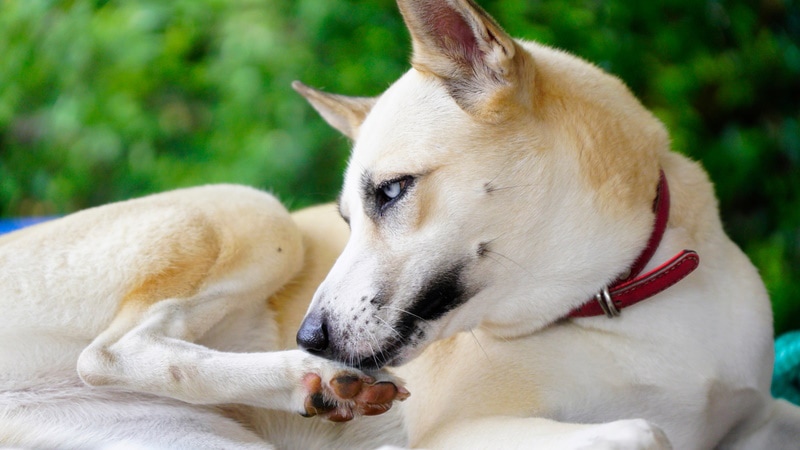
What are the Signs of Lick Granuloma?
The first sign owners usually report is a behavioral sign of excessive licking. They may not show any signs and just suddenly start licking more frequently or owners may already be aware that their dog has an underlying condition such as skin allergies. Some dogs may already be known to have a more nervous disposition. It depends on the individual dog and the situation. Usually, owners notice their dog licking their legs, especially the front legs and their paws.
- Alopecia (hair loss)
- Redness
- Scabs
- Crusting
- Ulcers
- Thickening of the skin
- Broken hairs
Lick granulomas can often be recognized as they present as a raised, oval-shaped, well-demarcated, hairless skin lesion that is firm and can be red and ulcerated. They are often wet as the dog will have been recently licking it, leaving saliva on the surface. Tissue fluid may leak from the exposed skin as well, contributing to the wet appearance. This complicates the healing process.
They can be found as a single lesion on one leg or multiple lesions spread over different legs.
What are the Causes of Lick Granuloma in Dogs?
Lick granulomas are unique in that they often have both psychological and physiological factors that contribute to the development of the lesion.
- Allergic skin disease (environmental triggers or food sensitivity)
- Bacterial infections
- Fungal infections
- Trauma/injury
- Parasites
- Arthritis in joints of the limbs
- Pain in other parts of the body
- Foreign bodies such as grass seeds
There can also be a behavioral component that triggers the licking initially or perpetuates the problem.
- Anxiety
- Stressors
- Boredom
- Fear
- Obsessive-compulsive behavior
Often it is a combination of physical and psychological factors that cause lick granulomas. This is why it is often a complex issue to treat as the physical factors need to be dealt with, and the psychological or behavioral issues need to be addressed as well. This can be an expensive and time-consuming process.

Diagnosis of Lick Granuloma in Dogs
Your vet will carry out a full physical exam on your dog, examining them from nose to tail. They will pay special attention to any lesions on your dog’s legs and check for signs of musculoskeletal problems and skin diseases. They will ask you about your dog’s recent behavior, if they have had a history of behavioral problems, or if you have noticed if they have suddenly started licking.
Your vet will need to know some important information about your dog’s history.
- Any known allergies
- Any other skin signs such as ear infections, rashes and itchiness elsewhere
- Any lameness or signs of pain
- What parasite preventative treatments your dog is on
- If there have been any changes in your dog’s diet
- Recent travel history
- Changes to the family dynamic (new baby, new pet, etc.)
- Obvious changes or stressors in their environment (strangers in the house, fireworks, etc.)
Often, if there is a lesion with the appearance of a lick granuloma, and your dog has a history of excessive licking, your vet will make a tentative diagnosis based on these two findings.
Your vet may decide to take x-rays of the affected limb to determine if there are any issues with the bones or joints. This is important to try to identify the underlying causes of the licking. Your vet may take blood tests and perform urinalysis to check blood cell counts and organ function to screen for diseases.
Your vet will also want to test the skin lesions present. This is important as it may be possible to identify the cause of the licking, and if there are any secondary bacterial or fungal infections that require medication.
- Skin swab: A swab of the skin can be taken. This collects any bacteria or fungi on the surface of the lesion to be sent off to a lab. It can be used to identify which antibiotics or antifungal medication will be effective against any organisms present.
- Tape strip: This involves using a piece of tape that is placed over the lesion to lift off whatever is present on the surface so that it can be examined under a microscope.
- Skin scrapes: A scalpel blade may be used to gently scrape the skin and get a deeper sample. This is often to look for parasites, in particular demodex mites which live in hair follicles.
- Biopsy: A sample of the lick granuloma can be taken, using a biopsy punch or scalpel blade. It is then sent to an external lab for histological examination and often bacterial culture.
How Do I Care for a Dog with a Lick Granuloma?
Treatment of lick granuloma in dogs involves treating the active skin lesions and the underlying cause. The first thing your vet will do is attempt to stop your dog licking. This may involve putting a head collar on your dog (the famous “cone of shame”) so that they cannot access their legs to lick. Your vet may also bandage any wounds to dress the area and keep it clean. This will also form a physical barrier to prevent your dog from licking.
There are lots of medications your vet can dispense to treat the immediate clinical signs, and also the underlying cause. Pain relief and anti-inflammatory medications are often used to make your dog feel more comfortable. Antibiotics and antifungal medication will be prescribed if indicated. Anti-anxiety drugs may also be prescribed in some situations.
Topical treatment can be used on the skin. This can also help the skin heal faster and combat secondary bacterial infections. Your vet may suggest a diet trial if a food allergy is suspected. They may advise a prescription hydrolyzed diet or a novel protein diet for the diet trial.
Your vet may recommend you consult a veterinary behaviorist if your dog is showing signs of extreme anxiety and stress or is displaying other repetitive behaviors too.
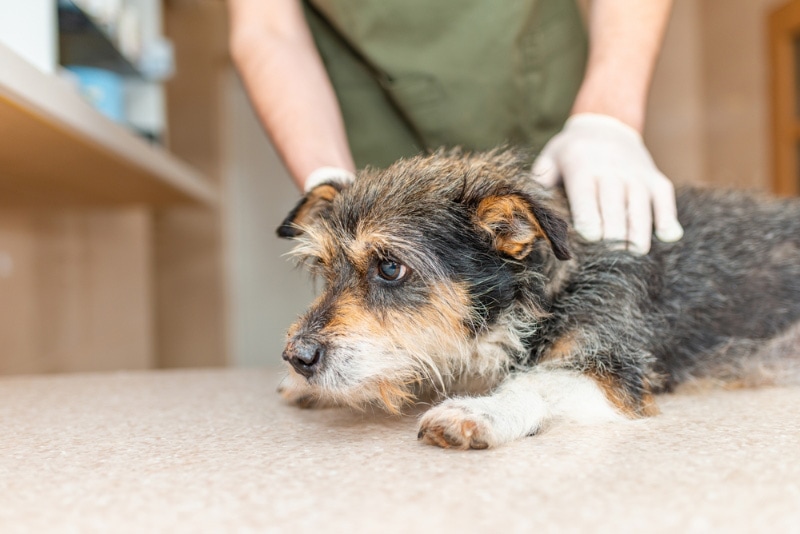
Frequently Asked Questions
Can you cover up a lick granuloma?
There are some advantages to covering up a lick granuloma. If it is covered, it will act as a physical barrier and prevent your dog from licking more. However, it may also encourage your dog to start licking in a new location and cause a second skin lesion. It is important to only cover the granuloma if you have been instructed to by your vet. Some owners can do more harm than good by bandaging the leg too tightly, for example.
What does a granuloma look like?
The classic appearance of a lick granuloma is an oval-shaped, raised, red or flesh-colored, hairless skin lesion. They are usually wet, and they can have blood or pus coming out of them depending on how long they have been there and how severe they are.
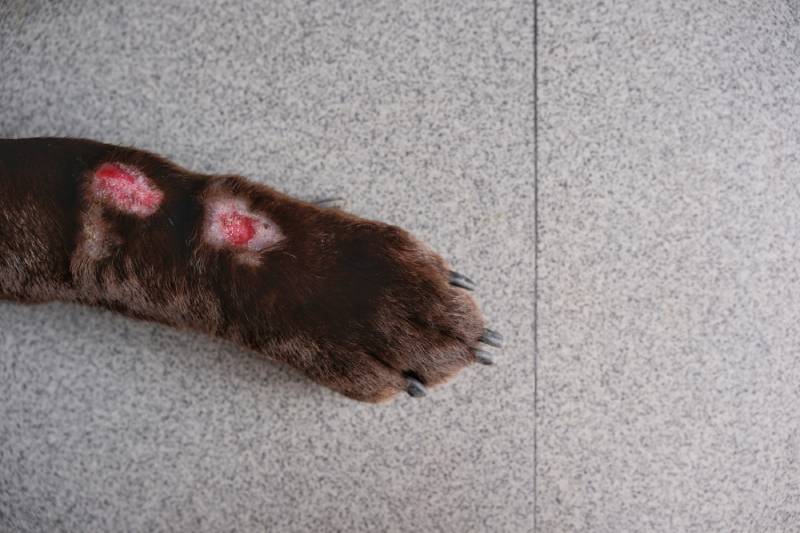
What happens if a lick granuloma is left untreated?
If a lick granuloma is left untreated, there can be severe consequences—your dog is capable of causing a great deal of trauma and the greater the risk of serious deep bacterial infection. The longer they are present, the more difficult they become to treat. Rarely, some granulomas clear up on their own. It is always important to try to prevent your dog from licking while the skin is healing.
Conclusion
Lick granulomas are relatively common skin lesions, usually seen on the lower limbs of dogs. They can be complicated as there can be many different contributing factors. They can also be challenging to treat, and the prognosis is usually poor. The condition is not life-threatening, however, it can be extremely uncomfortable for your dog and cause them a great deal of distress.
Owners can expect to be involved in long-term management of the condition once it has been diagnosed.
Featured Image Credit: PolyPloiid, Shutterstock





